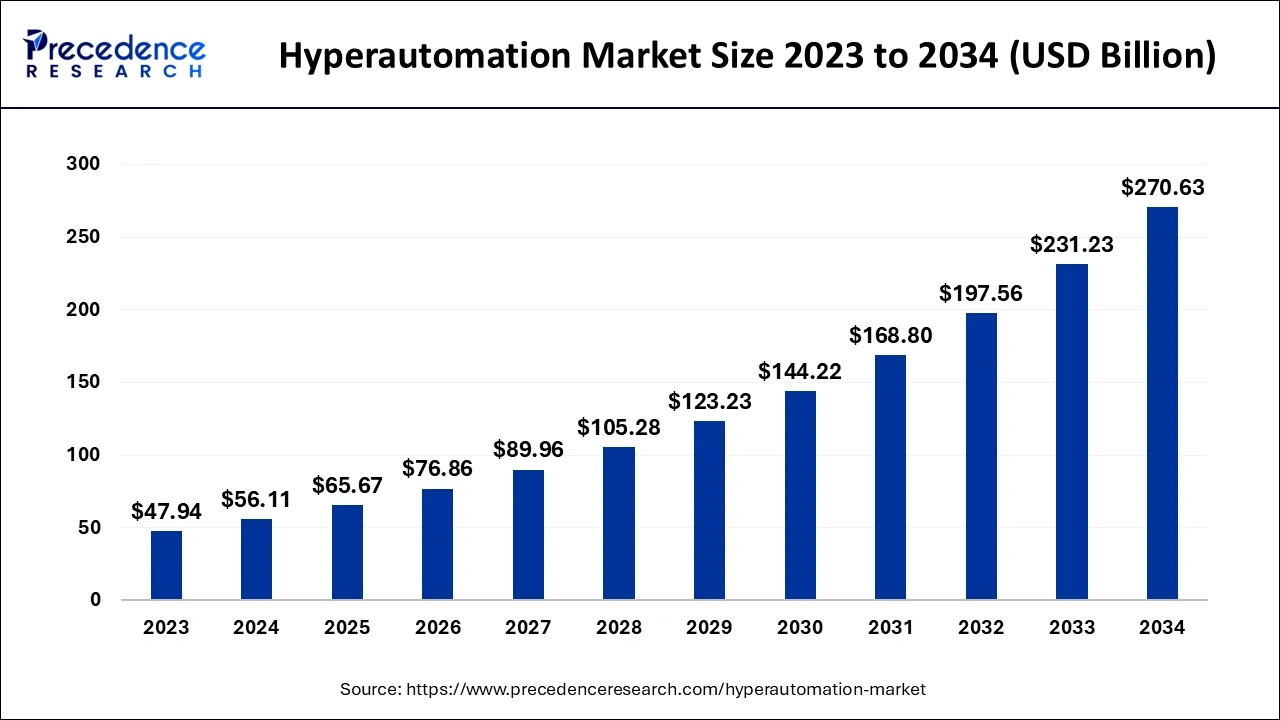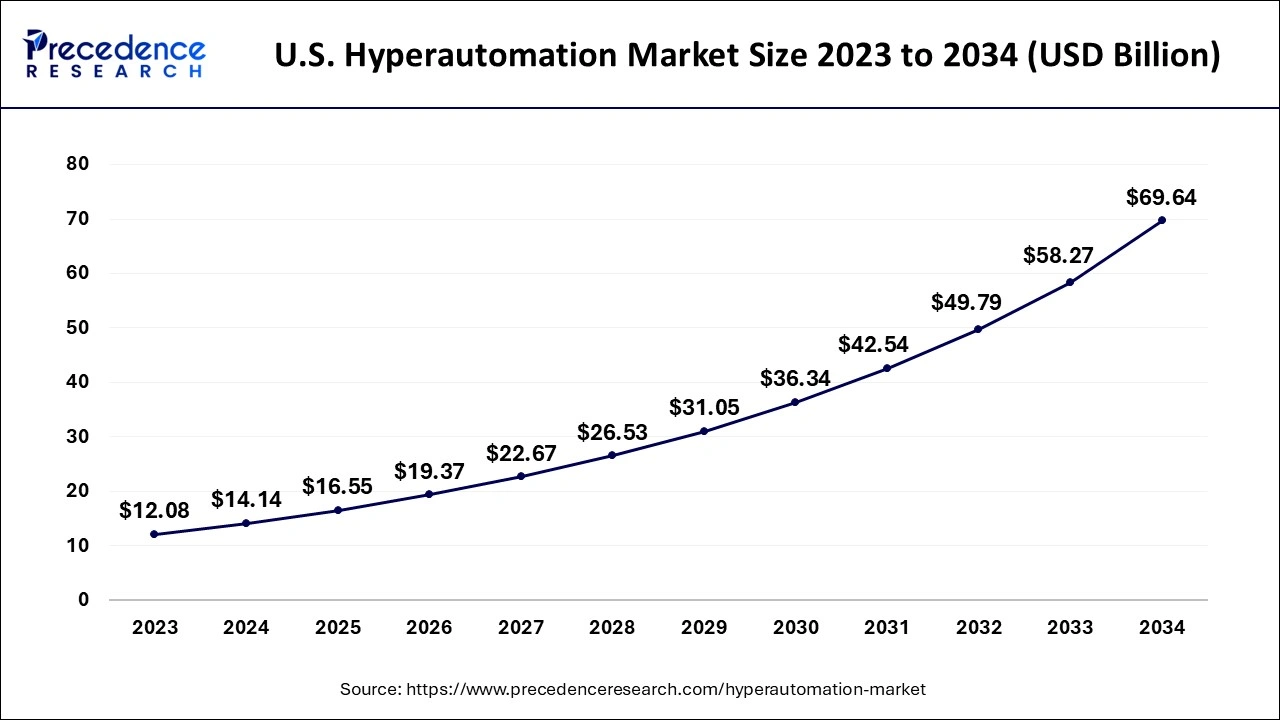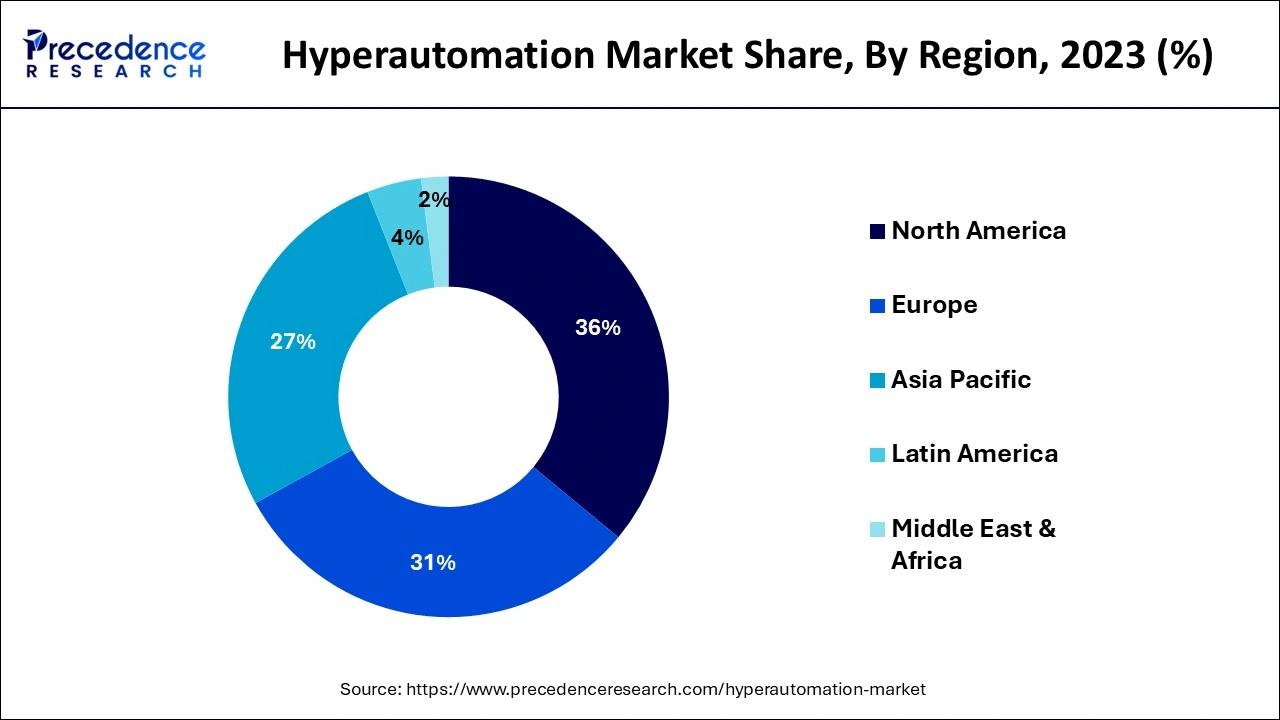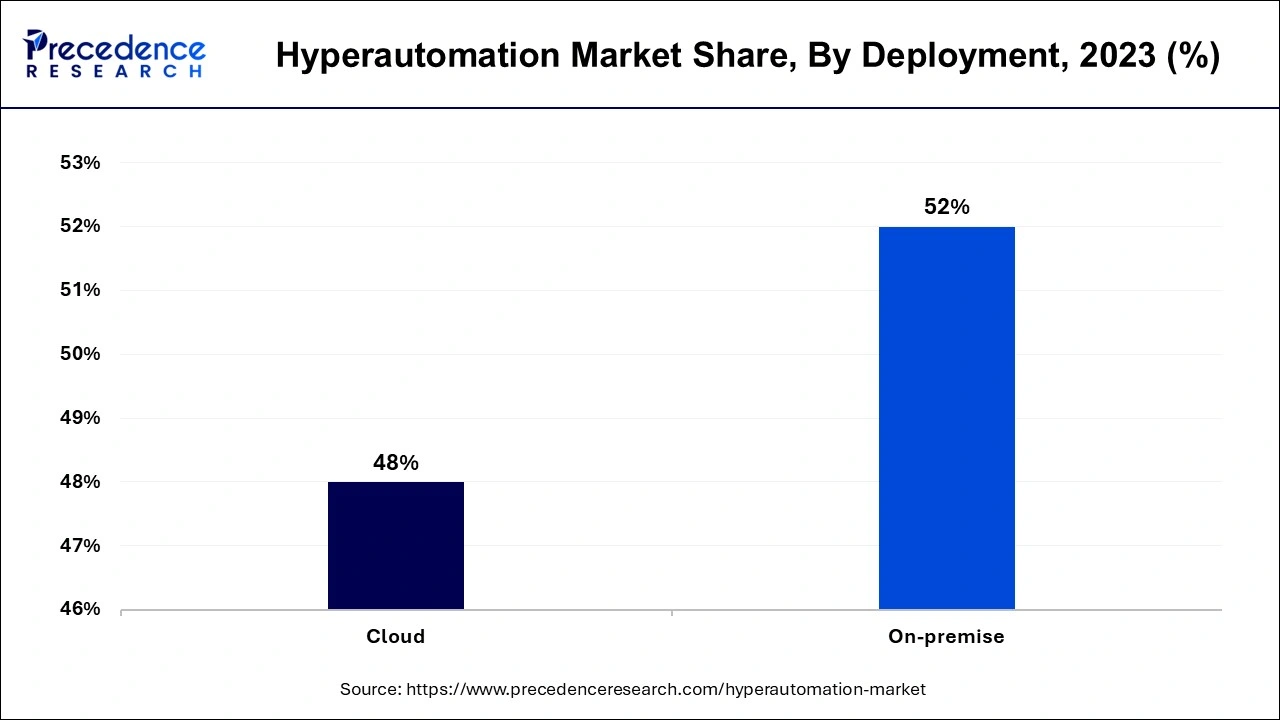The global hyperautomation market size is calculated at USD 56.11 billion in 2024, grew to USD 65.67 billion in 2025, and is projected to reach around USD 270.63 billion by 2034. The market is poised to grow at a CAGR of 17.04% between 2024 and 2034. The North America hyperautomation market size is predicted to increase from USD 20.20 billion in 2024 and is estimated to grow at the fastest CAGR of 17.2% during the forecast year.
The global hyperautomation market is expected to be valued at USD 56.11 billion in 2024 and is anticipated to reach around USD 270.63 billion by 2034, expanding at a CAGR of 17.04% over the forecast period from 2024 to 2034.

The U.S. hyperautomation market size is accounted for USD 14.14 billion in 2024 and is projected to be worth around USD 69.64 billion by 2034, poised to grow at a CAGR of 17.28% from 2024 to 2034.

North America dominated the market with the largest market size in 2023. The region is estimated to sustain its position throughout the forecast period due to the substantial potential of the region in the field of robotics. The growth of the market in the region is attributed to the rising industrial development in the region. The large-scale as well as small and medium scale industries including start-ups show willingness towards adopting automation solutions to boost the efficiency and productivity of their firm. Moreover, the presence of the IT and Telecommunication industries which generally work on the automation models in the region drives the growth of the hyperautomation market in North America.
According to the report published by Association of Automation, North American companies have ordered 9,186 units of robots in the first quarter of 2023. The total cost of this order is valued at $597 million. Considering the rising rate of automation through the implementation of robots in industries, the region is expected to witness a massive growth in the market in the upcoming years.

Asia Pacific is expected to witness the fastest rate of growth during the forecast period. The rising urbanization and industrialization in the region act as a major growth factor for the market. In Asia Pacific, multiple major companies and industries are actively participating in the shift towards digitization to sustain in the market, the element is expected to fuel the market’s growth in the region. Improving economies in countries of Asia Pacific also results in higher adoption of the hyperautomation systems and technologies in the organizations for better workflow and reduced operational costs.
The market in Asia Pacific is expected to be fueled with the rising emphasis on the innovation and development of robotics in the region. China especially, is estimated to have a significant development in the field of robotics. China’s Ministry of Industry and Information Technology has introduced ‘Robot + Application Action Plan’ which focuses on the development and improving the robotics sector by 2025. This element will improve the market’s position in the region in the upcoming years.
Hyperautomation is the process in which there are several automation tools that enable robotics automation processes, machine learning, and artificial intelligence to expand automation initiatives. Hyperautomation is the newest and emerging technological solution that plays several major roles in the development of industries such as collecting data or insights on the process, environment, and workflow.
Hyperautomation is also capable of identifying unstructured and structured data and inputs which are often required to fulfill the operations in management. Hyperautomation transforms organizational tasks by automating tasks and generating solutions while minimizing human intervention. Hyperautomation works on the principles of artificial intelligence, robotics automation processes, and other technologies which work effectively and brilliantly without any human support.
Hyperautomation carries multiple advantages in terms of offering efficient workflow of the business. It helps businesses to maintain consistency, speed, and accuracy which results in reduced cost of the process and enhances the consumer experience. There are various hyperautomation tools available as per the requirements of businesses. Hyperautomation works on the center on add on the more intelligences and an advanced system-based approach to expand the automation efforts. This capability of hyperautomation system is expected to boost its adoption in industries while acting as a growth factor for the market.
Hyperautomation reduces the cost of the business operations, it increases the association between IT and business. Hyperautomation increases the adoption rate of machine learning and artificial intelligence in organizations, as industries focus on prioritizing advanced technologies, the adoption of hyperautomation solutions is expected to increase.
| Report Coverage | Details |
| Market Size in 2024 | USD 56.11 Billion |
| Market Size by 2034 | USD 270.63 Billion |
| Growth Rate from 2024 to 2034 | CAGR of 17.04% |
| Largest Market | North America |
| Fastest Growing Market | Asia Pacific |
| Base Year | 2023 |
| Forecast Period | 2024 to 2034 |
| Segments Covered | By Component, By Deployment, By Technology, By Function, By Enterprise, and By End Use |
| Regions Covered | North America, Europe, Asia-Pacific, Latin America, and Middle East & Africa |
Booming e-commerce industry
The most emerging e-commerce industry has a plethora of space for automation. The E-commerce industry has a large emphasis on order processing since more people than ever utilize loyalty programs and shop online.
AI-based hyperautomation solutions are observed to fasten the front-end processes including targeted marketing via social media, advertisement placement and targeted email marketing. Additionally, hyperautomation has been used to track and assess market elements like pricing competition and client feedback, enabling quicker, more accurate decision-making that increases revenue and profitability. Hyperautomation also enables the improvement of accuracy, efficiency, and cost-effectiveness in back-end retail processes like procurement, billing, supplier management, inventory, and transportation. Thus, the element drives the market’s growth.
Higher acquisition cost
Installing hyperautomation systems in industries can be more expensive than traditional systems. Hyperautomation requires a substantial investment for transforming infrastructure, technology, and human resources. Small and medium organizations cannot apply the hyperautomation systems due the financial or capital constraints, hereby, the installation cost limits industries from adopting such solutions, thus acts as a restraint for the market.
Emerging trend of process mining
Process mining and hyperautomation can work hand-in-hand with process orchestration tools, the insights gained from process mining can feed into the process orchestration system, guiding the overall automation strategy and ensuring that automated processes work seamlessly together. Process mining can be combined with AI and machine learning techniques to uncover hidden patterns and insights that lead to better automation decisions. By leveraging AI, hyperautomation can be even more sophisticated and adaptive, handling complex processes with a higher degree of autonomy. Thus, the emerging trend of process mining is observed to open a plethora of opportunity for the global hyperautomation market.
The hardware segment dominated the market with the largest market share in 2023. The growth of the segment is attributed to the factor that hyperautomation hardware component increases the efficiency of operations, as the hardware works to enhance the effectiveness. Hyperautomation hardware is used by several industries such as healthcare, automobile, banking and finance, supply chain, etc. hyperautomation hardware combines several tools such as artificial intelligence, machine learning, robotic process automation, and other technologies for enhancing the ability to automate work in industries.
The cloud segment dominated the market in 2023, the segment will continue its dominance throughout the forecast period. Cloud-based deployment allows businesses to gain a larger amount of data for analyzing and conducting operations. As industries expand and transfer towards hyperautomation there is a need for huge data management tools or programs that can handle the enormous amount of data more accurately and precisely.

Traditional data management models are unable to store that amount of data and there is the requirement for a larger space for storing that data. Moreover, the data stored, and operation associated with the cloud-based systems can be generated and handles from any location, this benefit caused by the cloud deployment promotes the segment’s growth.
The robotics process automation segment is projected to witness the fastest growth in the market during the forecast period. The growth of the segment is attributed to the rising requirements for the massive amount of data storage in big data companies. Robotic process automation often works in the form of a tool that is based on the principles of automation technologies in industries. Robotics process automation utilizes software for performing higher-level business process activities without any human intervention.
It enhances the rate of customer satisfaction due to the 24/7 working chatbot and bots which minimizes the time of waiting of the consumers.
The sales and marketing segment held the largest share of the market in 2023. The segment will continue to sustain its position throughout the forecast period. Industries across the globe have started depending on the automation on generative processes for providing better leads to the sales team, and campaign accuracy. These factors contribute to the growth of the segment. Automation tools are the most valuable software in the growth of the sales and marketing industry.
The information which is gained by the sales and marketing automation tools can enhance the productivity of the industries by reducing the time taken for the operation. Sales and marketing automation is being widely utilized for website tracking and analytics, it analyzes and detects future potential customers on the website and gives valuable insights into their interests, needs, and inclination. The hyperautomation models are used in campaign tracking and construction; the tool is useful to detect the location of engagement.
The large enterprises segment dominated the market in 2023, the segment will continue to grow at a significant rate during the forecast period. Large-scale industries often carry a huge amount of data, unstructured and structured. The growth of the segment is attributed to the requirement for data analytics in large-scale industries. Large enterprises are shifting towards the digitization process to boost the productivity of the organization and manage operations. Hyperautomation improves management and governance processes, it minimizes the operation hurdle and costs. Hyperautomation helps to identify and eliminate the low-value workflow in the large enterprise. It increases the enterprise’s process documentation and standardization. Enterprise hyperautomation is the advanced steps toward the growth of the company's automation, predictive intelligence capabilities, and analytics. This also allows the businesses to shift from menial work to high-value tasks. Thus, it promotes the growth of the segment.
The IT and Telecommunication segment dominated the market in 2023. Hyperautomation simplifies the operational task in the IT and telecommunication sector. Hyperautomation is the most emerging technology in the IT and telecommunication sectors, that is revolutionizing the sector by enhancing cost-saving and improving efficiency. The IT and telecommunication industry actively participates in the adoption of advanced technologies as it has been observed to be one of the most competitive industries across the globe.
Hyperautomation provides insights for the IT and telecom firms to enhance operations and consumer satisfaction. Hyperautomation automates customer service tasks like answering queries and providing technical support. It automates network management tasks, like monitoring and provisioning. As the industry focuses on the adoption of generative and smart solutions to manage repetitive operations, the segment’s growth is expected to be fueled.
On the other hand, the retail segment is expected to witness a significant growth rate during the forecast period. With the emergence of e-commerce platforms, the retail industry is focusing on minimizing human errors. Improving business safety, optimizing sales, reducing operational costs and customer satisfaction. All these requirements are excellently fulfilled by hyperautomation solutions. Moreover, the retail industry is expected to utilize the hyperautomation solutions and systems to boost sales. Order confirmation, processing sales history, improved visibility and customer engagement can be achieved by such solutions. All these factors considered in the industry are expected to fuel the segment’s growth.
Segments Covered in the Report
By Component
By Deployment
By Technology
By Function
By Enterprise
By End Use
By Geography
For inquiries regarding discounts, bulk purchases, or customization requests, please contact us at sales@precedenceresearch.com
No cookie-cutter, only authentic analysis – take the 1st step to become a Precedence Research client